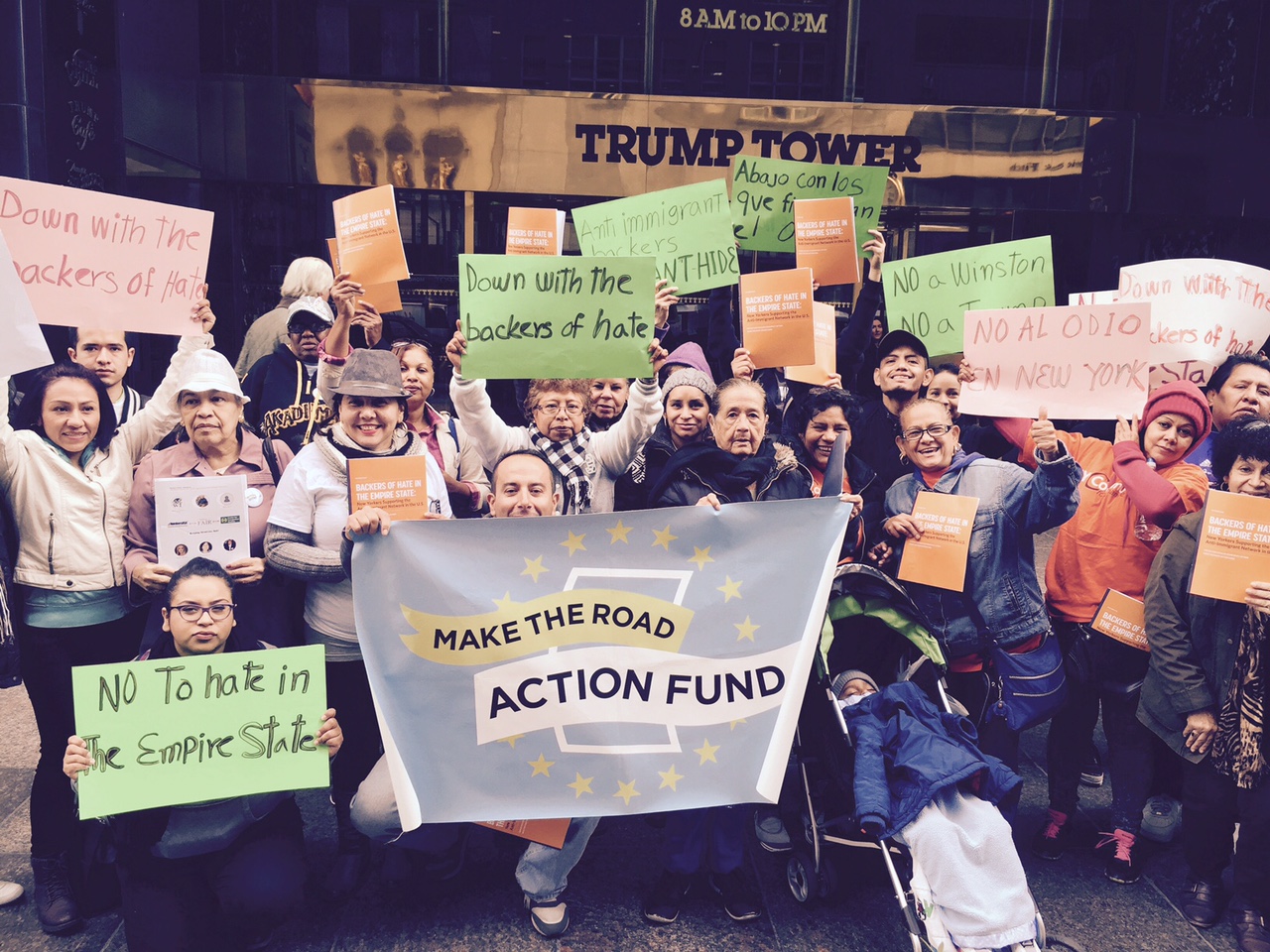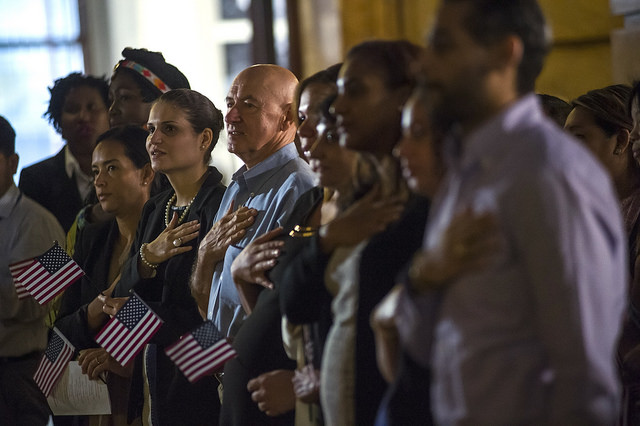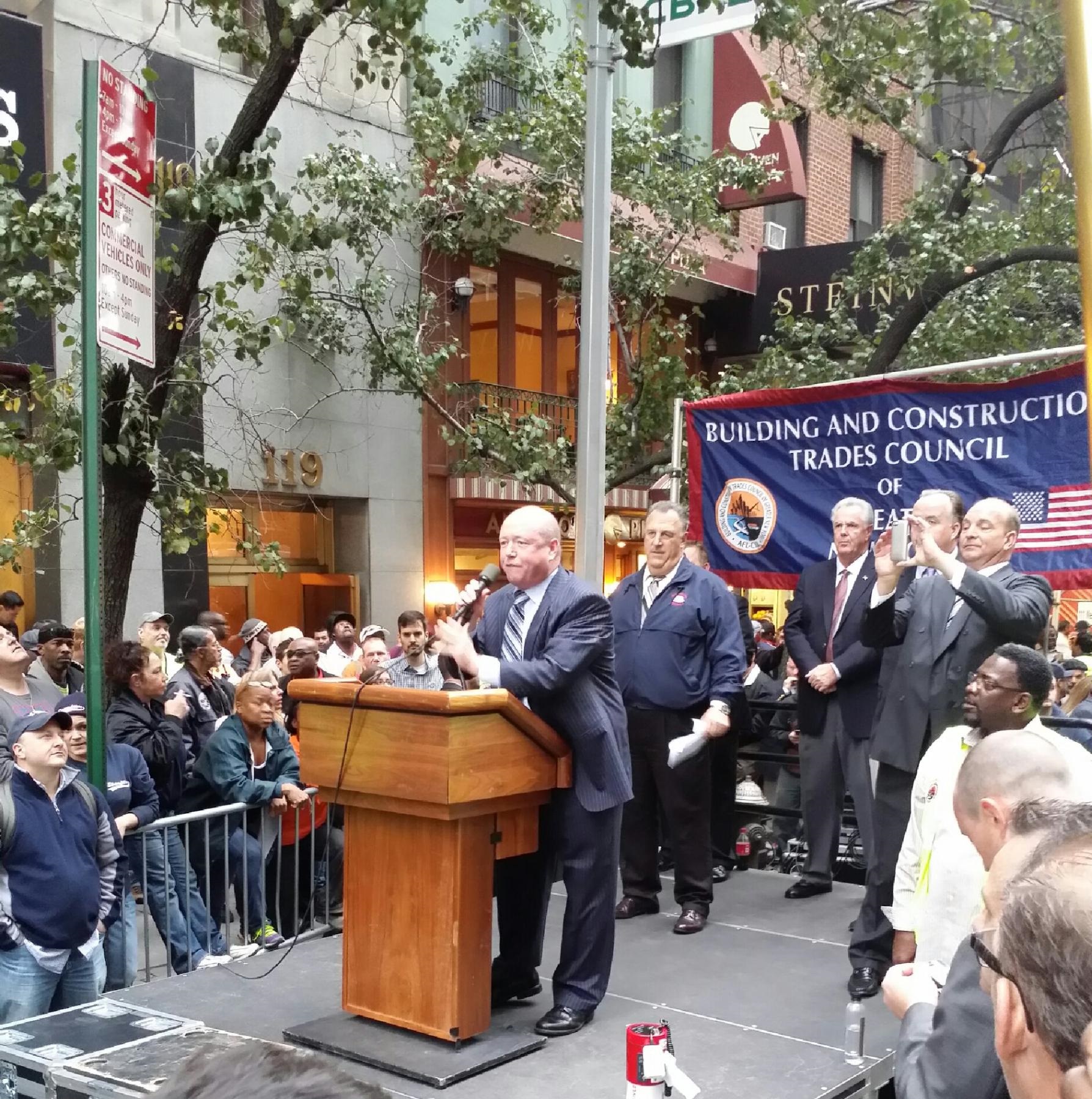Saying No to Hate in the Empire State

Protesting anti-immigrant messaging
As two of the 4.3 million immigrant members of this state, we, like most of our community, came to New York City with high hopes of acceptance and opportunity. And we love our city. We love how diverse it is, how progressive its values are, and how we have so much opportunity to work together to identify problems and fight for solutions.
One thing we do not love, however, is that there is a group of wealthy New Yorkers working against our immigrant communities to make us feel unwelcome and to separate our families.
As a new report, "Backers of Hate in the Empire State" (which the organizations to which we belong produced with the Center for Popular Democracy Action) has revealed, there is a group of wealthy New Yorkers who are using their millions and elite networks to fund and support the anti-immigrant movement in this country. And the anti-immigrant rhetoric and organizing they are behind is now tragically seeping into our nation's political arena.
That's why, this week, more than 50 immigrants like us joined together recently to protest in midtown Manhattan to call out the backers of hate. These organizations and individuals work together to create an irrational fear of immigrants and they work in favor of anti-immigrant policy. Individuals like Barbara Winston, beneficiary of the Winston gem fortune, have supported anti-immigrant groups for years, and now candidates like Donald Trump and Carly Fiorina are following this lead.
The rhetoric of Trump and other Republicans reflects the hate and lies of these groups. And the same is true for policy. Like anti-immigration groups such as the Federation for American Reform (listed as a hate group by the Southern Poverty Law Center), Keeping Identities Safe, the Center for Immigration Studies, and NumbersUSA, leading GOP candidates oppose immigration relief and a path to citizenship for undocumented immigrants, and they want to get rid of birthright citizenship.
Most New Yorkers disagree with these extreme views, and that's why we're fighting back. We first picketed outside a jewelry store owned by members of the Winston family, and then marched and continued to rally outside of Trump Tower. Our march traced the dangerous connections between the backers of hate in New York State and the toxic conversation around immigration that Republican candidates have launched. This followed several other protests against Mr. Trump himself, at which immigrant New Yorkers have directly confronted him for his anti-immigrant positions.
It's time for the millionaires and billionaires who are using their resources to back anti-immigrant movements to stop and instead use their money and energy to improve schools for our children and housing for our communities—to create a better future for this nation. But, while they continue their anti-immigrant work, it's critical that politicians, the media, and other organizations cut ties with individuals and organizations who support a hateful, anti-immigrant agenda. New York should be a progressive beacon for our country—not a haven for hate.
***
by Maria Rubio, Make the Road Action Fund, and Elva Meneses, New York Communities for Change.
More NYC Families Will Soon Have Access to Care

A citizenship ceremony (photo: Ed Reed, Mayor's Office)
New York City's new plan will expand access to care for immigrants across the City
Access to health care is on the rise all across New York City, thanks to federal, state, and city efforts over the last few years.
For example, the latest data show that the number of people who are uninsured dropped 34 percent from 2013 to 2014. That's the good news. The bad news is that many of the remaining uninsured New Yorkers still face daunting barriers to access basic care because of their immigration status or because they don't yet speak English fluently. Indeed, during the congressional debates on the Affordable Care Act, immigrants were treated as the "poison pill" for the legislation, and during debates on immigration reform, health care coverage is similarly sidelined.
We are working to change that dynamic at the local level. With Mayor de Blasio's new plan to improve immigrant access to health care, we are creating a more equitable city. Over the coming months, we will launch the Direct Access project, to explore an affordable system that will provide comprehensive primary and preventive care to immigrants who are ineligible for support under the Affordable Care Act. This project's success will serve as the basis for a more inclusive health care system, including families in our city without access to insurance.
Direct Access is a recommendation of the Mayor's Task Force on Immigrant Health Care Access, a group of City government officials, community advocates, health care professionals, hospital administrators, and public health experts. The Task Force's recommendations acknowledge that many immigrants face unique struggles in accessing care. Many who do not yet have full English proficiency have difficulty finding help in their language. Some encounter a health care system that seems dauntingly unfamiliar. Others find themselves excluded from access to care due to our broken federal immigration system's outdated rules and the failure of multiple attempts at federal reform.
These barriers mean that far too many of our fellow New Yorkers are relegated to a second-class health care system in which they must forgo basic medical care such as check-ups, cancer screening, and chronic care management. Instead they are forced to rely on inefficient emergency room visits and overburdened neighborhood providers, with little to no opportunity for follow-up care. This means that our immigrant family members and neighbors often do not get sufficient basic health care, resulting in missed workdays and unnecessary illness, and a cost that we all share.
The Affordable Care Act, passed in 2010, has helped to solve these problems for millions of Americans. It has expanded access to health care across the country, providing support to nearly all low-income and moderate-income Americans to get health insurance.
But that qualifier—"nearly all"—makes a big difference in our diverse city. According to our analysis, as many as 345,000 uninsured New York City residents who live, work, and raise their families here will remain uninsured because they are ineligible for help under the Affordable Care Act due solely to their immigration status. That is more people than the entire population of St. Louis. Much, perhaps most, of this population would benefit from proposed immigration reforms or the President's November 2014 executive actions. However, all of those measures have been held up in congressional committees or in the courts, victim to political calculations.
We cannot wait for others, in D.C. or Albany, to solve this problem for us. The health and safety of our residents is ultimately our responsibility, and the Mayor's plan represents a bold step forward—the first effort in the country since the implementation of the Affordable Care Act to grow immigrant health care access.
The Mayor's new immigrant health effort is the first step towards a more inclusive health care system. This will strengthen our health care system, our immigrant communities, and our city as a whole.
***
by Nisha Agarwal, Commissioner, NYC Mayor's Office of Immigrant Affairs. On Twitter at @NYCImmigrants.
***
Have an op-ed idea or submission for Gotham Gazette? E-mail editor Ben Max: This email address is being protected from spambots. You need JavaScript enabled to view it.
New York’s Much-Needed New Task Force to Combat Worker Exploitation

Pat Dolan, the author, at a rally
Governor Andrew Cuomo has just announced an initiative to combat worker exploitation in New York, including investigations focused on employers who are serial offenders, along with the creation of a hotline for reporting worker abuse.
At the first public meeting of the New York Task Force to Combat Worker Exploitation, on October 14, abused workers came forward to give firsthand accounts of living lives in virtual serfdom for employers giving little consideration towards abiding by our state laws, safety or wage mandates.
The ten-agency task force will coordinate data collection, investigations, prosecutions, and compliance, as well as outreach and education with workers and employers, made possible with a $700,000 state allocation.
The findings will shed light on the widespread mistreatment of workers, especially within New York's construction industry, which accounts for less than four percent of statewide employment but 20 percent of the state's occupational fatalities. 3
At the first public hearing, five workers testified about abuses they have suffered on their worksites including racial discrimination, sexual harassment, wage theft, assault, and lack of worker's compensation for when they are injured on the job.
"It's just an abusive system that's going on around here," said Carrol Turner, a non-union construction worker, originally from the island of Jamaica, who discussed repeated instances of wage theft among his co-workers. "You don't have the slightest idea what's going on, especially in the non-union construction world. You have to live it to tell what's going on."
In his more than 13 years with his employer, Mr. Turner testified that he never received safety or industry training and admitted many of his co-workers had been injured on the job. He recalled an instance when his supervisor threatened to fire him if he didn't return to work immediately after receiving an on-the-job injury to one of his fingers that necessitated medical treatment.
According to the U.S. Labor Department's report, Adding Inequality to Injury: The Costs of Failing to Protect Workers on the Job, it is estimated that worker's compensation covers only 21 percent of workplace injury and illnesses. Costs are then primarily footed by employees, their families, and their private health insurance (63 percent), while taxpayers are socked with 16 percent of the tab. But what if your employer provides no healthcare coverage, as is the case with many of these workers?
When asked by a Task Force committee member if his workplace displayed information regarding worker's compensation, Mr. Turner responded, "Plenty of us don't even have an idea there is a thing called worker's compensation."
In construction, falls are the most common cause of serious workplace injuries and comprise half of fatalities in New York State. This occurs in spite of federally-mandated rules requiring safety equipment on worksites including harnesses and safety lines, nets, guard and stair rails. In 2012, 79 percent of fatal fall accidents occurred at non-union construction sites and 60 percent of victims were immigrant and/or Latino, according to the New York Committee for Occupational Safety & Health (NYCOSH).
Another non-union construction worker, Carlos, testified with only his first name, fearing vengeance from his employer after coming forward with stories of assault and wage theft. During Hurricane Sandy, he worked for a contractor at a federal building for 12-14 hours per day without ever seeing a dime. "When you complained about that, they would retaliate against you," he said. The punishment? Taking employees off the work schedule for days, even weeks at a time.
These are some of many tactics used to threaten and intimidate employees in New York's growing and seedy underground construction economy. Those who testified told of scraping by on wages as little as $5 per hour while working 50-60 hour weeks, with no healthcare protection should they become sick or seriously injured on their job site. Many are kept silent by the threat of losing their meager earnings, which can be the difference in providing a hot meal for their families or making rent payments.
The governor's new effort to battle rampant worker exploitation should not be a brief, formulaic exercise. When it is becoming more the norm for workers across our city to be forced to work on dangerous construction sites ten or 20 stories above street level without basic safety gear or training, or perhaps earning half of minimum wage, it's truly time to reexamine what our priorities are. The Governor's Task Force to Combat Worker Exploitation is welcome and necessary.
***
Patrick Dolan Jr. is the President of the 8,200-member Steamfitters Local Union 638. Members of Steamfitters Local 638 install and maintain high-efficiency, state-of-the-art heating, air conditioning, ventilation, fire-suppression and sprinkler systems in commercial, residential and industrial buildings in New York City.




